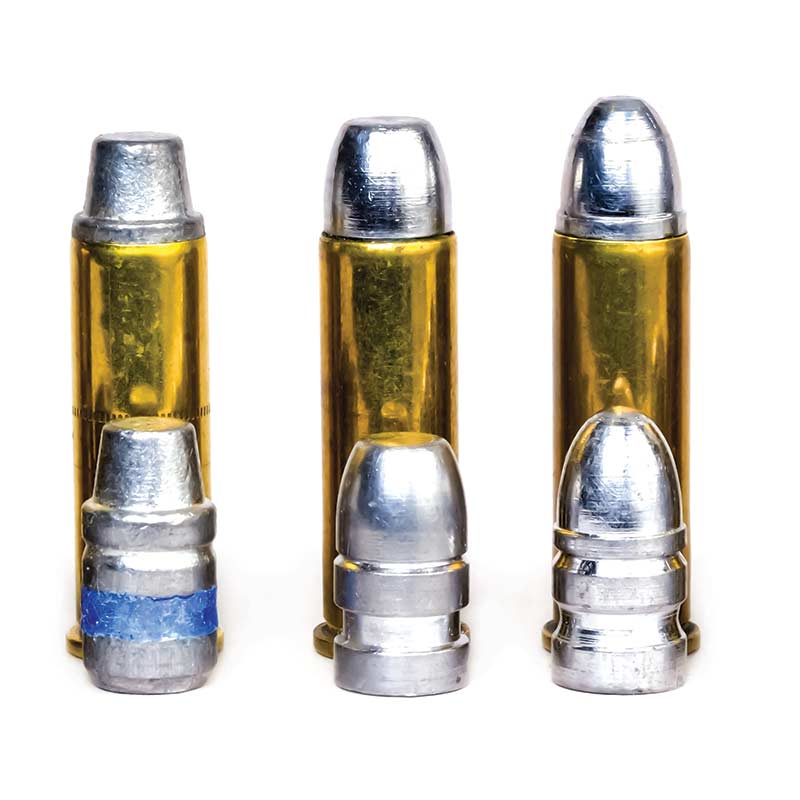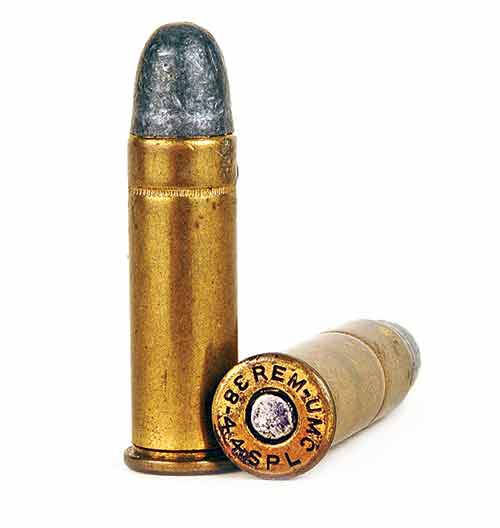Duke’s current two Big .38 Specials are (left) S&W Outdoorsman (later Model 23)
and 2nd Generation Colt SAA.
Today we think of .38 Special mostly as a self-defense round for snub nose revolvers, But, before .500, .480, .475 and .460 revolvers, before .357, .41 and .44 Magnums, before even +P .38 Special factory loads, there was the .38-44. It was introduced in 1930 and featured a 158-gr. RN bullet just like the one used in standard .38 Special factory loads except nominal velocity was a whopping (for those days) 1,150 fps. The idea was to give a hotter factory load for police, one that would penetrate automobile windshields and doors of the many criminals roaming the roads during the 1930s.
Heavy Duty
Because of its high pressure, S&W had to introduce a new big revolver specifically for .38-44s. It was built upon their large N-Frame that accounted for the somewhat strange name — a .38 caliber revolver on a .44 size frame. In those days S&W, and Colt too for that matter, did not give model numbers to their handguns. Instead they got names. The new .38-44 was named Heavy Duty and came in 4″, 5″ and 61/2″ barrel lengths with the middle one being far more common. I don’t have evidence of that; it’s just my experience-based opinion.
The Heavy Duty was a utility style sixgun with a groove down its topstrap serving as the rear sight and half-moon shaped front sight. Thereafter S&W brought out a second BIG .38-44 named Outdoorsman. It had a fully adjustable rear sight and the square shaped front called Patridge. The only barrel length offered as standard on the Outdoorsman version was 6.5″. After S&W transitioned to model numbers the Outdoorsman became the Model 20 and the Heavy Duty became the Model 23.
Colt was not about to let a good thing pass and soon specified their large frame DA New Service was suitable for .38-44 loads as well as the Colt Single Action Army. The former DA Colt was offered in 4.5″, 5.5″ and 7.5″ barrel lengths and the SA came in 4.75″, 5.5″ and 7.5″ lengths. Both Colts had the traditional grooved topstrap and blade front sights, but Colt also offered their target sighted Shooting Master in .38 Special.
Magnum Impact
With the advent of magnums — .357 in 1935, .44 in 1956 and .41 in 1964 — interest in .38-44 pretty much died. And of course, the ability to shoot such loads in any .357 Magnum accelerated its demise. By 1966 S&W dropped both the Models 20 and 23. Colt let the New Service expire in 1944 but when the SAA was reintroduced in 1956 .38 Special and .45 Colt were its caliber choices. By 1964 the company had dropped the .38 Special.
Boys Will Be Boys
As big .38 Specials disappeared from the catalogs of new handguns a West Virginia hillbilly kid began his handgunning career with a beloved S&W K-38 and a setup for making .38 Special handloads. One of my most fondly remembered friends that senior year of high school was named Mike Bucci (pronounced “Butch”). His father was our town’s chief of police. He approved of our interest in shooting and gave “Butch” his old .38 Special duty gun so we could shoot together. It was an S&W Heavy Duty with a 5″ barrel. The local gun club was only three miles from our high school, so Butch and I spent many late afternoons plinking away with our .38s. Later, when I started loading .45 ACP Chief Bucci would allow us to take the department’s Thompson Submachine Gun out by ourselves. Yes, it was a different era.
Perhaps Butch’s Heavy Duty was the reason I developed a lifelong affinity for sixguns of yesteryear. Factory loads for .38-44 were gone by that time, but as a careful handloader I was able to copy them. Not having a chronograph, we thought .38-44 ballistics were duplicated.
Butch and I still got an idea of how regular .38 Specials and .38-44s differed. For my K-Frame .38 the usual handload was 3.0 grains of Bullseye with 150-gr. lead bullets. For Butch’s Heavy Duty we loaded 11.0 grains of 2400 with the same bullets. My load would knock over old bricks from about 50 feet. Butch’s loads busted them. My .38 Special would knock over chunks of wood. The bullets stayed inside. Butch’s bullets penetrated completely.
By the late 1960s, I began spending summers in Montana and Butch got married. Mid-summer of 1971, I got word Butch had died from a rare form of cancer. I never saw his guns again, but my exposure to .38-44 as a big handgun cartridge stayed with me. I never did land a Colt New Service or Shooting Master .38 Special but have owned all three barrel lengths of .38 Special Colt SAAs. Several S&W Heavy Duty/Model 23s have passed through my hands, including one HD factory lettering to the first year of production. Those are gone but an Outdoorsman (pre-Model 20) given to me by a friend is here as is a like-new SAA .38 with 7.5″ barrel.
Home Grown .38-44s
So, what does it take to turn a .38 Special into a .38-44? First off you need a big .38 revolver, although S&W K-Frame .357 Magnums and medium frame Colt Python and Trooper .357s will suffice. Next you need some common sense. The .38-44 is not a .357 Magnum. Don’t try to make it one. That old load I used of 11.0 grains of 2400 with 150-gr. bullets is an absolute maximum. It used to appear in old reloading manuals even for K-Frame S&W .38s which is where I found it back in 1966. Modern manuals are far more conservative so hear me — stick with big .38 revolvers for .38-44 shooting.
Here’s an alternative. For me .357 Magnums are ear ringers even with good ear protection. Many people shoot .38 Specials in their .357s for this reason. If an intermediate load will suffice then .38-44 ballistics can be achieved by loading down .357 Magnums. Stick with .357 Magnum cases and still use 2400 powder but go one grain (only) over what I listed for .38-44 — 12 grains of 2400 with 150- to 160-gr. lead alloy bullets. I personally favor the RN/FP designs from RCBS and Lyman. Such handloads will put a .357 Magnum in the old .38-44 ballpark.
Those handloads from my big .38 revolvers gave near amazing accuracy. From my Ransom Pistol Machine Rest, my Outdoorsman and Colt SAA gave 12-shot, 25-yard groups of 1.5″ or less. That’s the sort of sixgun precision anyone can be proud of.






2 replies on “BIG .38 SPECIAL IS THERE REALLY A DIFFERENCE? WRITTEN BY MIKE “DUKE” VENTURINO”
Dear Mr. Venturino,
My name is Frank Castro and I live in Coral Gables, Florida. I own a S&W 38 Special that belonged to my father that passed away in 1984. I’m 62. I’m trying to determine the origin of this gun. On the left side of the barrel it has “Smith & Wesson”. On the butt is the serial number D315727. On the right side of the frame it has
“Made In U.S.A.
Marcas Registradas
Smith & Wesson
Springfield, MASS.”
Is there any way to determine when this revolver was produced?
Thank you,
Frank Castro
Dear Sir,
My name is Dave (Grumpy) and I am the one who is running my Blog (You will shoot your eye out). Anyways I just copied the article and have nothing to do with Mr Venturino, Moving on, I wish to offer my condolences for the loss of your father. I really miss mine!
Next a couple of questions about the S&W 38 Special Pistol that your Father left you. In that I need some more information about it. So that I can accurately tell you more about it. So here goes!
I am going to assume that it is a revolver. If so, would you open up the cylinder and look around the hinge? There should be a bunch of numbers stamped down near it.
The top numbers are the serial numbers and should match the serial numbers of the butt of the pistol. The bottom will tell us what model it is. Also I HIGHLY recommend that you look at the butt strap and see if there are any other letters. If so the gun might have belonged to a Police Dept or the US Military. which could add to its value.
Anyways I wish you luck and thanks for reading my blog!
Grumpy